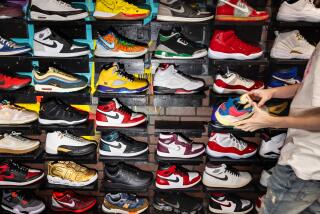Knocked off by a bargain
- Share via
I make my living writing about scams.
Check-cashing schemes, Nigerian frauds, fake Viagra -- I’ve covered them all. And in the back of my mind was always the sense that the victims must be a bit greedy or stupid.
Like me.
My comeuppance came this year when I went shopping online for high-end earphones and ended up with a fake.
And I don’t mean crude knockoffs. I thought I was getting a brand-name product at a bargain price by being a smart shopper, just like my flea-market-loving mom taught me.
Lately, fake merchandise has become a genuine menace, moving far beyond the bogus Rolexes and Louis Vuitton handbags that have been sold for decades with a wink and a nod. Counterfeit toothpaste showed up in discount stores in June and fake wine has been popping up at auctions. In May, the Food and Drug Administration warned about counterfeit versions of the Xenical weight-loss drug purchased by consumers online.
The Internet opens up new vistas for hunting down the lowest possible price. And for getting scammed.
“It used to be that counterfeits was what you saw on a street corner in New York,” market researcher Lauren Freedman said. “Now the whole world is a street corner.”
When the Sennheiser CX-300 earphones arrived, they looked perfect. The black earbuds were adorned with company logos, the asymmetric cord was just the right length and the silver plug fit an iPod perfectly. They came in a snazzy Sennheiser package with text in six languages.
I had wanted a set of these earphones ever since I gave them a rave review last year in The Times. They sounded great and fit snugly in the ear. Perfect for gym workouts, just in case I ever got back to the gym.
List price -- $79.99. But only a fool pays list. Amazon.com had them for about $65.
I wasn’t about to stop there. On the same Amazon product page was a link to Amazon Marketplace, where anyone can put an item up for sale. That’s where the CX-300s were being offered for less than $25.
A drop from list price of more than 66% raised a warning flag, even though the seller with the best price, Wifipro, had a positive customer feedback rating. I wrote him an e-mail asking: Was the product, at his price of $24.99, used, refurbished or damaged?
Wifipro’s reply: “These units are brand spanking new in factory blister pack, not returns, not used and not refurbished.
“They are a beautiful product at an unbelievable price.”
I was sold. The price was so good, I almost felt like a bandit.
Indeed, it was a “beautiful product.” But only, as it turns out, if you admire the work of counterfeiters.
--
Counterfeit electronic products have a history of being so obviously flawed that they’re jokes. For example, U.S. Customs and Border Protection officials in Long Beach recently displayed seized packs of what were intended to look like Duracell batteries, except that the label read “Dinacell.”
These days, no one in the industry is laughing much.
“I’ve seen fakes with our case, our logo, our address, even our instruction booklet, all faithfully reproduced, “ said Lou Lenzi, a senior vice president for product management at Audiovox Corp., which makes a variety of electronics.
When the CX-300s arrived from Wifipro, I removed the medium-size cushions from the earbuds and tried replacing them with the smaller ones included in the package to better fit my ears.
But they wouldn’t stretch over the earbuds, no matter how much I pulled on them. I figured someone else must have run into the same problem, so I did a search on the Web.
That’s when I first came across a site: “How to spot fake Sennheiser cx300.”
Still no worries. The fake depicted was a crude copy. But further digging made it clear there were several different fakes in circulation.
Finally, I happened upon a posting from a man who had bought a set identical to mine, also at a huge discount. He had sent a picture to Sennheiser and got a reply that the earphones “are almost certainly fake.”
My heart sank. Now I knew what it was like to get cheated online. It was made worse by the fact that I thought myself so clever for getting such a bargain.
I sent the earphones to Sennheiser’s experts, who said they were among the best counterfeits they had seen.
There was a clue, right on the front of the package.
“Look on the front where it says ‘Blocks Outside Noise,’ ” said Uwe Sattler, technical director at Sennheiser. Under that, in the German translation, was the word Aussengerauche.
“They forgot the umlaut -- the two little dots -- over the second ‘a,’ ” Sattler said.
Ah, the mystery of the missing umlaut. If I had been the German version of one of the Hardy Boys, I might have caught it.
“The fakes,” said Jeff Alexander, Sennheiser’s U.S. marketing chief, “are getting so much better.”
And not just of Sennheiser products. Counterfeits of Audiovox’s universal remote controls, sold under the RCA brand, have been cropping up worldwide.
“It used to be that you needed a very sophisticated facility to produce something like that,” Lenzi said, “but now the technology is so widely available.”
The counterfeiters start with reverse engineering to study the design and components, he said. Then, plastic injection machines and circuit board printers can be programmed to make a clone. Up to a point.
The emphasis is on appearance, not functionality. “It only has to be in good-enough operating condition to function, at least some,” Lenzi said.
The counterfeit CX-300s varied greatly in audio quality. Andy Ukasick of Milwaukee bought a pair on EBay that he learned were fakes.
“They sounded terrible,” he said in an interview. “No better than what you could pick up for $3.”
Ian Moore of Chester, England, who got his on Amazon Marketplace, fared better. “The sound was good, but not what you expect from Sennheiser,” he said. “There was no real bass.”
Moore sent an e-mail to the seller, questioning the product’s validity. He immediately got a reply from a Mr. Hussain, offering a full refund.
“Then I knew they were fakes,” Moore said. “You expect the seller to say, ‘How dare you.’ But he was very apologetic.”
Ukasick also got a quick refund from his seller -- Wifipro.
--
I set out to find the man behind the moniker, Sidney Jacobs. It wasn’t hard -- his name and return address were on the package the earphones arrived in. He operates his business in Southern California, only about 30 miles from my home.
Jacobs, 66, wasn’t trying to hide. His picture was in his EBay seller’s profile, where he described himself as a “Vietnam-era Vet” who had worked for large corporations. “I have said goodbye to the business suits, stuffed shirts and power ties,” Jacobs wrote.
According to comments left on EBay and Amazon Marketplace, buyers started to identify the earphones as counterfeit in July, shortly after Jacobs began selling them. At first, he made fun of doubters.
“This is a very sick person,” Jacobs wrote in response to negative feedback from an EBay buyer.
It was time to give Jacobs a call. He said that to start his online sales company, he bought Sennheiser earphones from an offshore distributor which he declined to identify. I told him that Sennheiser confirmed that the earphones he sold me were counterfeit. Jacobs didn’t express shock but blamed the distributor.
“I had asked about the legitimacy of the products,” Jacobs said, “and they said ‘Yes, yes. They’re the real thing.’ ”
Jacobs said he didn’t know there might be a problem until several buyers questioned the authenticity of his earphones. Jacobs said they all got refunds. And with word getting around the Web about fake CX-300s, he prepared a note for customers. It was sent to potential buyers who specifically asked by e-mail if the earphones he was selling were the real thing.
“My products are in original factory package,” said the note. “They look great and sound great. That being said, I will not guarantee with 100% certainty that they are genuine.”
No such warning appeared on his selling sites.
Jacobs said he couldn’t send the earphones back to the distributor. And he had a tale of woe: a son still living at home, a mother-in-law with serious health problems.
“I have several thousand dollars invested in these items,” Jacobs said. Besides, he was never completely convinced all his earphones were counterfeit. He pointed out that most of his customers, as evident in his feedback, were happy with the earphones they had received at a huge discount.
Jacobs asked if his name could be kept out of the newspaper. I told him no.
Finally, the specter of being identified as the seller of counterfeit goods outweighed the financial loss.
“You have put fear in my heart,” Jacobs said. The earphones had to go.
“I am removing them immediately,” he said, typing frantically in the background. “There, they are gone.” Shortly after we spoke, $24.99 plus $4.99 for shipping was returned to my credit card account.
That was a surprise. I never asked for a refund, between feeling slightly sorry for the guy and fretting about my journalistic ethics -- after all, I was getting a story out of it.
Of course, counterfeits are still out there. Plenty of sellers still offer CX-300s at prices as low as $15 on the Internet.
I used to love to find bargains like that. Getting scammed was a good lesson, but it also took some of the fun out of the hunt.
“You know the old saying about, ‘If it’s too good to be true it probably isn’t’?” said Freedman, the e-commerce analyst. “Well, it’s true.”
My mom used to say that too. It was the part of her shopping lesson I relearned the hard way.
--
More to Read
Inside the business of entertainment
The Wide Shot brings you news, analysis and insights on everything from streaming wars to production — and what it all means for the future.
You may occasionally receive promotional content from the Los Angeles Times.











